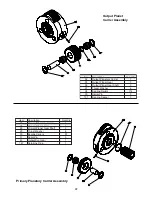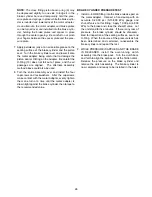
11
HOIST OPERATION
The following warnings and instructions are basic to safe hoist operation. Please read them carefully and follow
them each time your hoist is operated. These instructions are provided in addition to any information furnished by
the Original Equipment Manufacturer. Equipment operators should be completely familiar with the overall opera-
tion of the piece of equipment on which the hoist is mounted (i.e. crane, truck crane, etc.). If you have any ques-
tions concerning the safe operation of this hoist or the equipment it is mounted on, contact the equipment manu-
facturer that installed the hoist, or the Braden Product Support Department at 918-251-8511, Monday through
Friday, 0800 to 1630 hours CST, by fax at (918) 259-1575, or via the internet at www.paccarwinch.com.
Ground personnel must stay in view of the operator
and clear of the load and hoist drum at all times. Do
not allow personnel near the hoist line under ten-
sion. Do not allow personnel near the hoist drum
while the hoist is in operation. Do not allow person-
nel to be in line with the load. Do not allow person-
nel to stand under a suspended load. A safe dis-
tance of at least 1
½
times the working length of the
cable should be maintained by ground personnel. A
broken cable and/or lost load may cause property
damage, personal injury or death.
Failure to properly warm up the hoist, particularly
under low ambient temperature conditions, may
result in temporary brake slippage due to high back
pressures attempting to release the brake, which
could result in property damage, severe personal
injury or death.
Failure to use the proper type and viscosity of plan-
etary gear oil may contribute to intermittent brake
clutch slippage which could result in property dam-
age, severe personal injury or death. Some gear
lubricants contain large amounts of EP (extreme
pressure) and anti-friction additives which may
contribute to brake slippage and damage to brake
friction discs or seals. Oil viscosity with regard to
ambient temperature is also critical to reliable
brake operation. Our tests indicate that excessive-
ly heavy or thick gear oil may contribute to intermit-
tent brake slippage. Make certain that the gear oil
viscosity used in your hoist is correct for your pre-
vailing ambient temperature.
Warm-up Procedures
A warm-up procedure is recommended at each start-up
and is essential at ambient temperatures below +40°F
(4°C).
The engine should be run at its lowest recommended
RPM with the hydraulic hoist control valve in neutral
allowing sufficient time to warm up the system. The
hoist should then be operated at low speeds, raise and
lower, several times to prime all lines with warm
hydraulic oil, and to circulate gear lubricant through the
planetary gear sets.
After the hoist/boom is properly positioned, we recom-
mend the operator slowly pay-out, then haul-in a short
length of cable. The hoist should perform these opera-
tions in a smooth and controlled manner. If the hoist
does not operate smoothly or makes any unusual
sounds, the source of the problem should be identified
and corrected before any attempt is made to lift a load.
Slowly pay-out wire rope from the hoist drum until it
reaches the load. Securely fasten the hoist cable to the
load and be sure all ground personnel are a safe dis-
tance from the load. Slowly lift the load a short distance
and stop. A small amount of “bounce” may be
observed, depending on the weight of the load, size and
type of wire rope, reaving and the amount of boom
extension. Allow the load to stabilize and then watch for
any sign of downward movement or cable drum rota-
tion. The hoist static brake should hold the load in place
without allowing any downward movement at all. If the
load creeps down, it should be lowered to the ground
immediately and the source of the problem identified
and corrected.
If the hoist is holding the load securely, proceed with
normal operations in accordance with the equipment
manufacturer’s operating procedures and load charts.
If the hoist is mounted on a crane that has an extend-
able boom, care must be taken to pay-out cable as
the boom is extended. Failure to pay-out sufficient
cable could result in a “two-blocking” condition that
could result in damage to and/or failure of the hoist,
cable, sheaves and/or boom.
CAUTION



























